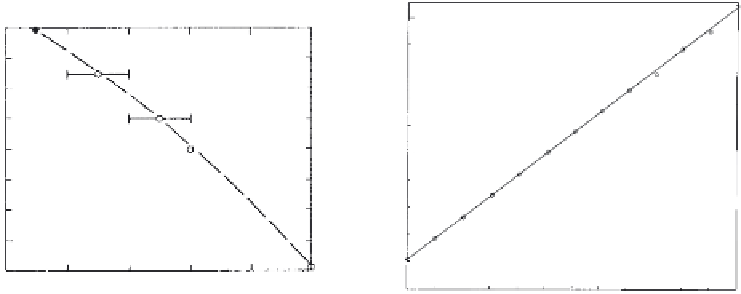Geology Reference
In-Depth Information
It may also be hindered by the presence of a snow cover, or a salt crust or hard pan at the
surface. For these reasons, wind abrasion is probably least effective in the summer
months.
The majority of wind abrasion in high latitudes probably occurs during the 6 -10 months
of winter by wind-driven snow particles. It is well known that the hardness of ice is a
function of temperature. Moh hardness values can reach the equivalent of those of
orthoclase feldspar (Moh hardness of 6) in the extreme Antarctic winter (Figure 10.8A).
Also, cold air is denser than warm air, and thus the corresponding threshold velocity that
is needed to take a grain into saltation is lower in cold environments than in hot environ-
ments (Figure 10.8B). Laboratory experiments support the hypothesis that many wind
abrasional features are produced in response to collisions by suspended dust particles
rather than by saltating sand grains (Whitney and Dietrich, 1973). Field experiments using
asbestos boards exposed to snow-laden katabatic winds in the Sor Rondane Mountains of
Antarctica indicate maximum erosion takes place at a distance of
30-40 cm above the
ground surface (Matsuoka et al., 1996). It is also during winter that winds are strongest
and most constant because well-developed high-pressure systems become established over
the polar landmasses. Widespread wind erosion on the Qinghai-Xizang (Tibet) Plateau,
however, is attributed to strong diurnal winds associated with night-time cooling of
uplands. As such, it is a year-round process.
Wind abrasion is a form of natural sand-blasting. Its effectiveness is a function of hard-
ness of the material being abraded, hardness of the abrading agent, and wind velocity. The
most common wind-erosional features are ventifacts. These are smoothed, fl attened,
fl uted, faceted, or grooved pebbles or boulders that have suffered modifi cation from expo-
sure to strong wind-transported abrasive material (Figure 10.9A).
In the high northern latitudes, ventifacts have been reported from northeast Greenland
(Fristrup, 1953) and Siberia (Sverdrup, 1938) but are relatively rare in the lowlands of the
Canadian Arctic islands (Bird, 1967; Pissart, 1966a), presumably because wind velocities
are insuffi cient for entrainment of abrasive material. Long-term observations made upon
a number of ventifacts from near Paulatuk, a small coastal community in Western Arctic
Canada that is subject to year-round katabatic winds from adjacent uplands, suggest that
∼
(B)
(A)
45
0
ICE
-10
-20
-30
-40
-50
-60
-70
-80
1
40
2 3
Hardness number on Moh's Scale
4
5
6
35
-70 -60 -50 -40 -30 -20 -10
0
10
20
30
40 50
Temperature (°C)
Figure 10.8.
Snow as an abrasive agent. (A) Hardness of ice as a function of temperature; values
may reach the equivalent of those for orthoclase feldspar (hardness 6) in the extreme Antarctic
winter. More typically, at
40°C ice has a hardness of 4, similar to fl uorite. (B) Threshold wind
velocity required to lift a 2 mm granule to a height of 2 m at various temperatures. From Selby
et al. (1974). Reproduced by permission of The Royal Society of New Zealand.
−





